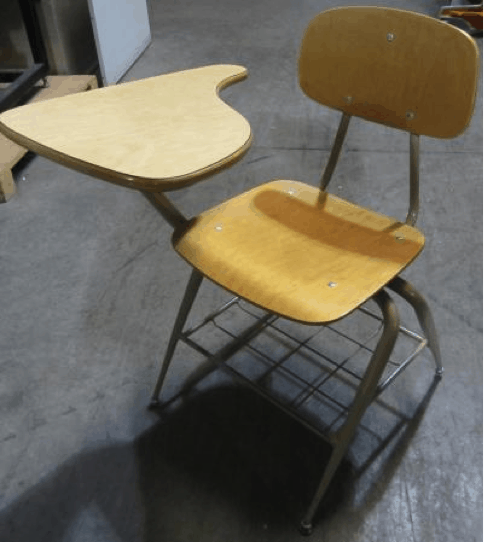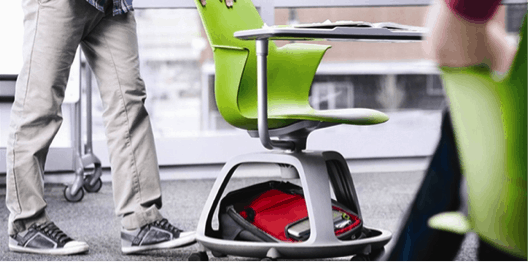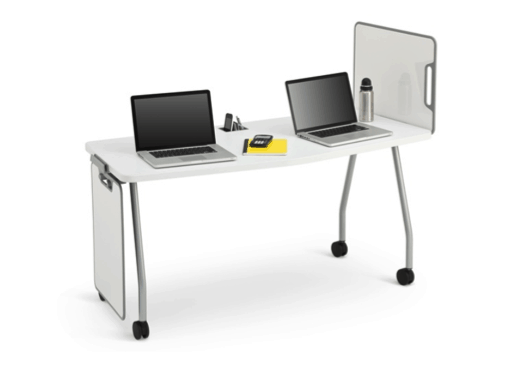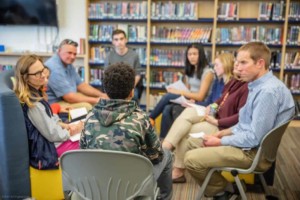Can Classroom Furniture Improve Student Engagement?

Victoria Bergsagel
When I was a principal observing classrooms I would often ask teachers about the types of feedback they wanted. Without fail, the most popular request was, “Tell me if my students are engaged.”
Going round-and-round about the types of data to collect, we would discuss how to cultivate passionate learners. We would consider students’ thoughts, feelings, behaviors and achievements. But back-in-the-day when students wedged themselves into what we affectionately called the one-armed bandit, we rarely considered how the actual furniture in the room might help.
Measuring Engagement
Fast forward several years and I now find myself working with educators to physically design more engaging learning environments.
Always on the look-out for resources that will help teachers leverage opportunities to cultivate more successful school cultures, one research article recently caught my eye.
Found in the Winter 2013 edition of the peer-reviewed journal Planning for Higher Education, the article offers twelve factors of student-engagement.
- Collaboration
- Focus
- Active involvement
- Opportunity to engage
- Repeated exposure to material through multiple means
- In-class feedback
- Real-life scenarios
- Ability to engage ways of learning best
- Physical movement
- Stimulation
- Feeling comfortable to participate
- Creation of an enriching experience
In the study, students and faculty were asked to compare their experience in traditionally-furnished classrooms with an environment designed to provide more flexibility in learning.
The results showed that classrooms designed for active learning—i.e., where physical space supports a focus on engaging experiences for students and faculty—had a statistically significantly effect on student engagement (p<0.001).
Flexibility, Collaboration and Making Learning Visible
Instead of filling classrooms with one-armed bandits, schools are increasingly populating their learning environments with flexible tables on castors, comfortable chairs and plentiful writing surfaces. Why? Because:
- Easily-moved tables allow for a variety of activities and encourage collaborative learning experiences.
- Chairs that students can swivel and move help to improve comfort and attention.
- Lots of erasable markers to write on whiteboards, specially-painted walls, and even windows, allow thinking to become more visible.
Educators have known for some time that when students are encouraged to show their work publicly in emotionally-safe environments, they move beyond a fear of failure and learn to iterate together in meaningful ways. Given the right tools and mindset, they become adept at problem-solving together in successful approximations. Building upon one another’s thinking, they learn to cultivate a culture of collaboration and the skills they will need for success in the 21st century.
A Grant Opportunity
Cognizant that creative spaces featuring flexibility and inspirational aesthetics lead to greater student engagement, I was intrigued to read more about Steelcase Education’s pursuit of educational innovation.
Their Active Learning Center (ALC) grant, due February 27, 2015, hopes to help educators better implement active learning initiatives by leveraging the design of their physical space. Fifteen grants (valued between $35,000 and $50,000 each) will supply furniture, integrated technology, design, installation and post-occupancy evaluation for a classroom designed for 28 – 32 students. (Eligible classrooms must be in the United States and Canada and serve grades 6 – 12 or students in a college or university.)
Over the two-year program, Steelcase will also evaluate student and educator engagement in the newly designed spaces using their Active Learning Post Occupancy Evaluation.
Chosen grantees will have the opportunity to install Steelcase-developed learning environments, including the Node, Verb or Blended Learning classroom.
Many are familiar with the Node chair. Featured on 60 Minutes, the Node was designed by David Kelly and his team at IDEO. Allowing students to swivel and move about easily, it even provides a convenient place for a backpack.
The Verb team table system, while designed for group work that requires interaction and collaboration, maintains the ability to offer a personal work space as well. (For those times when students need privacy for testing or focus, small whiteboards can become privacy dividers.)
The Blended learning system includes a variety of components that allow instructors and students to customize their space for the activity at hand, since furnishings can easily morph from lecture mode, to independent or team work, to presentation, to discussion and back again.
A Community of Practice
For me, the most appealing feature of this grant is the fact that, in addition to receiving new classroom furniture, grantees will obtain professional development regarding student engagement. Best of all, they will also be given the opportunity to participate in a community of practice with other awardees to share insights and best practices.
Just Imagine
In today’s most progressive and celebrated schools, technology is ubiquitous, collaboration celebrated and movement encouraged. Multiple activities take place in adaptable environments.
Furnishings can aid or inhibit student engagement.
Just imagine the innovation and inspiration that can be born of active learning.
For more on design, check out:
 Victoria Bergsagel is the Founder and President of Architects of Achievement and currently works as an educational design strategist. Author of Architecture for Achievement, Victoria is a former teacher and principal. Follow Victoria on Twitter with @archachieve.
Victoria Bergsagel is the Founder and President of Architects of Achievement and currently works as an educational design strategist. Author of Architecture for Achievement, Victoria is a former teacher and principal. Follow Victoria on Twitter with @archachieve.
Photos courtesy of Steelcase Education.












John
In 2005 I did away with the desks in my 6th grade classroom and went to round tables. This immediately improved collaboration among students, taught students to share space, and improved overall floor space in the classroom. Since 2005, other teacher in my school have followed this example. Prior to the tables I would put my students in small groups, but they were still in desks.
Victoria
Great job John. It's amazing what big changes such a small one can make!
Pat Kane
I have been involved in a lot of R&D on this in NZ. Refer to papers http://furnware.co.nz/research-papers.
I have since moved into other areas of learning spaces management and development but this remains my passion!
Pamela Kennedy
Here is a condensed time lapse in my third grade classroom from Monday February 8, 2016. I call it Perpetual Motion in Room 17. Thanks to DonorsChoose, I been able to ditch the desk one old fashioned piece of furniture at a time. We now have Hokki stools, Zuma cantilever chairs and six Steelcase Node chairs. Students love them all!
http://mskennedyroom17.blogspot.com/p/time-lapse-sample-of.html
ronak
thanks for your perfect article i'd use it for my presentation in education furnitures :)
Kevin Stoller
It's great to see people and companies thinking about this. We usually start with the end in mind to figure out the concept, then fill in the right furniture to achieve that concept. There are so many ways to do it, and learning from others success (and failure) is key. That's why we are host webinars to allow schools to get an overview on the options and hear from others that have recently implemented things like this. Our next webinar is June 8th: www.kay-twelve.com
Becca Holton
It makes sense how furnishing can aid or inhibit student engagement. I remember being in middle school and not being able to focus because my desk would wobble. I figure that I'm not the only one who easily get distracted and could have benefited from furnishing in better condition.
Birchi
Thanks for sharing your view about classroom furniture. I am sure people will enjoy your class room furniture items and Your IDEA about classroom furniture.
Adrian Jones
One way to make sure that students engage more is if the furniture that they use is very comfortable and is conducive to let them think more critically since even something so simple as furniture can help make or break a person's way of thought and how they'll respond to doing activities. At the same time, making sure that the chair is easily accessible to people of all ages and demographics, especially for disabled students, is something that should be kept in mind. If I had the chance to make a chair that would be usable by all, I'd make sure that the chair would not only be comfortable but easy to move around in.